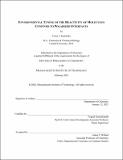| dc.contributor.advisor | Yogesh Surendranath. | en_US |
| dc.contributor.author | Kaminsky, Corey J.(Corey Jarin) | en_US |
| dc.contributor.other | Massachusetts Institute of Technology. Department of Chemistry. | en_US |
| dc.date.accessioned | 2021-05-25T18:21:31Z | |
| dc.date.available | 2021-05-25T18:21:31Z | |
| dc.date.copyright | 2021 | en_US |
| dc.date.issued | 2021 | en_US |
| dc.identifier.uri | https://hdl.handle.net/1721.1/130823 | |
| dc.description | Thesis: Ph. D., Massachusetts Institute of Technology, Department of Chemistry, February, 2021 | en_US |
| dc.description | Cataloged from the official PDF of thesis. | en_US |
| dc.description | Includes bibliographical references. | en_US |
| dc.description.abstract | The heterogenization of molecular catalysts to polarized interfaces provides an appealing approach to the design of more efficient and selective electrochemical devices. The well-defined nature of molecular catalysts renders them amenable to synthetic tuning to unravel structure-function relationships. From these studies, key insight to optimization of their activity is obtained. However, recent work has established that outer-sphere effects such as the surface structure and ligation method can impact reactivity as much as catalyst structure. This thesis explores these environmental contributions to reactivity with a particular focus on exploring the impact of electronic coupling between a molecular site and the band structure of graphitic carbon electrodes or using this coupling as a tool to understand the reactivity of molecules confined to solid-liquid interfaces. Chapters two through four explore environmental contributions to porphyrin electrocatalysis. | en_US |
| dc.description.abstract | We report on how the magnitude of electronic coupling conferred by the linkage tunes the rate of oxygen reduction catalysis. We further demonstrate solvent-dependent concerted proton electron transfer for a cobalt porphyrin attached to graphitic carbon by an alkyl-tether. Building on these results, we present a mechanistic basis for the stark differences in the selectivity and activity of heterogenized and soluble cobalt porphyrins for the CO₂ reduction reaction. Chapters five and six address charge effects at solid-liquid interfaces. In chapter five, we analyze the rate of dissociative ligand exchange for identical heterogeneous and soluble binding sites and find a modest rate enhancement that we attribute to the enhanced charge stabilization by the solid support. | en_US |
| dc.description.abstract | Chapter six details our attempt to use ambient pressure X-ray photoelectron spectroscopy to experimentally test our previously established model for catalysts strongly electronically coupled to the band states of graphitic carbon by direct measurement of the interfacial electrostatic potential drop. | en_US |
| dc.description.statementofresponsibility | by Corey J. Kaminsky. | en_US |
| dc.format.extent | 238 pages | en_US |
| dc.language.iso | eng | en_US |
| dc.publisher | Massachusetts Institute of Technology | en_US |
| dc.rights | MIT theses may be protected by copyright. Please reuse MIT thesis content according to the MIT Libraries Permissions Policy, which is available through the URL provided. | en_US |
| dc.rights.uri | http://dspace.mit.edu/handle/1721.1/7582 | en_US |
| dc.subject | Chemistry. | en_US |
| dc.title | Environmental tuning of the reactivity of molecules confined to polarized interfaces | en_US |
| dc.type | Thesis | en_US |
| dc.description.degree | Ph. D. | en_US |
| dc.contributor.department | Massachusetts Institute of Technology. Department of Chemistry | en_US |
| dc.identifier.oclc | 1252627508 | en_US |
| dc.description.collection | Ph.D. Massachusetts Institute of Technology, Department of Chemistry | en_US |
| dspace.imported | 2021-05-25T18:21:31Z | en_US |
| mit.thesis.degree | Doctoral | en_US |
| mit.thesis.department | Chem | en_US |
